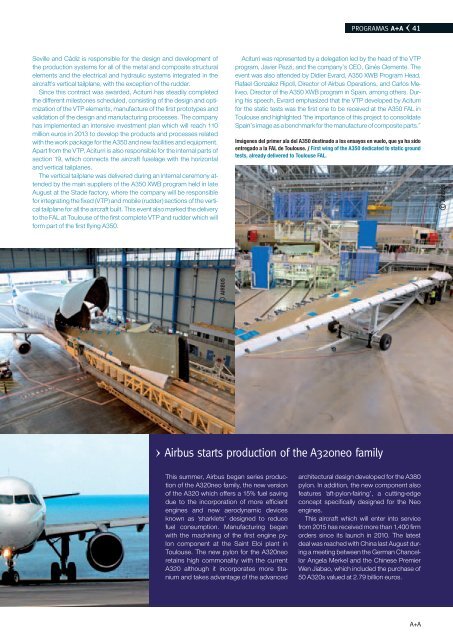El cluster aeroespacial - Helice Foundation
El cluster aeroespacial - Helice Foundation
El cluster aeroespacial - Helice Foundation
You also want an ePaper? Increase the reach of your titles
YUMPU automatically turns print PDFs into web optimized ePapers that Google loves.
Seville and Cádiz is responsible for the design and development of<br />
the production systems for all of the metal and composite structural<br />
elements and the electrical and hydraulic systems integrated in the<br />
aircraft's vertical tailplane, with the exception of the rudder.<br />
Since this contract was awarded, Aciturri has steadily completed<br />
the different milestones scheduled, consisting of the design and optimization<br />
of the VTP elements, manufacture of the first prototypes and<br />
validation of the design and manufacturing processes. The company<br />
has implemented an intensive investment plan which will reach 110<br />
million euros in 2013 to develop the products and processes related<br />
with the work package for the A350 and new facilities and equipment.<br />
Apart from the VTP, Aciturri is also responsible for the internal parts of<br />
section 19, which connects the aircraft fuselage with the horizontal<br />
and vertical tailplanes.<br />
The vertical tailplane was delivered during an internal ceremony attended<br />
by the main suppliers of the A350 XWB program held in late<br />
August at the Stade factory, where the company will be responsible<br />
for integrating the fixed (VTP) and mobile (rudder) sections of the vertical<br />
tailplane for all the aircraft built. This event also marked the delivery<br />
to the FAL at Toulouse of the first complete VTP and rudder which will<br />
form part of the first flying A350.<br />
© AIRBUS<br />
Airbus starts production of the A320neo family<br />
This summer, Airbus began series production<br />
of the A320neo family, the new version<br />
of the A320 which offers a 15% fuel saving<br />
due to the incorporation of more efficient<br />
engines and new aerodynamic devices<br />
known as ‘sharklets’ designed to reduce<br />
fuel consumption. Manufacturing began<br />
with the machining of the first engine pylon<br />
component at the Saint <strong>El</strong>oi plant in<br />
Toulouse. The new pylon for the A320neo<br />
retains high commonality with the current<br />
A320 although it incorporates more titanium<br />
and takes advantage of the advanced<br />
PROGRAMAS A+A<br />
Aciturri was represented by a delegation led by the head of the VTP<br />
program, Javier Pezzi, and the company’s CEO, Ginés Clemente. The<br />
event was also attended by Didier Evrard, A350 XWB Program Head,<br />
Rafael Gonzalez Ripoll, Director of Airbus Operations, and Carlos Meliveo,<br />
Director of the A350 XWB program in Spain, among others. During<br />
his speech, Evrard emphasized that the VTP developed by Aciturri<br />
for the static tests was the first one to be received at the A350 FAL in<br />
Toulouse and highlighted “the importance of this project to consolidate<br />
Spain’s image as a benchmark for the manufacture of composite parts.”<br />
Imágenes del primer ala del A350 destinado a los ensayos en vuelo, que ya ha sido<br />
entregado a la FAL de Toulouse. / First wing of the A350 dedicated to static ground<br />
tests, already delivered to Toulouse FAL.<br />
41<br />
architectural design developed for the A380<br />
pylon. In addition, the new component also<br />
features ‘aft-pylon-fairing’, a cutting-edge<br />
concept specifically designed for the Neo<br />
engines.<br />
This aircraft which will enter into service<br />
from 2015 has received more than 1,400 firm<br />
orders since its launch in 2010. The latest<br />
deal was reached with China last August during<br />
a meeting between the German Chancellor<br />
Angela Merkel and the Chinese Premier<br />
Wen Jiabao, which included the purchase of<br />
50 A320s valued at 2.79 billion euros.<br />
A+A<br />
© AIRBUS


